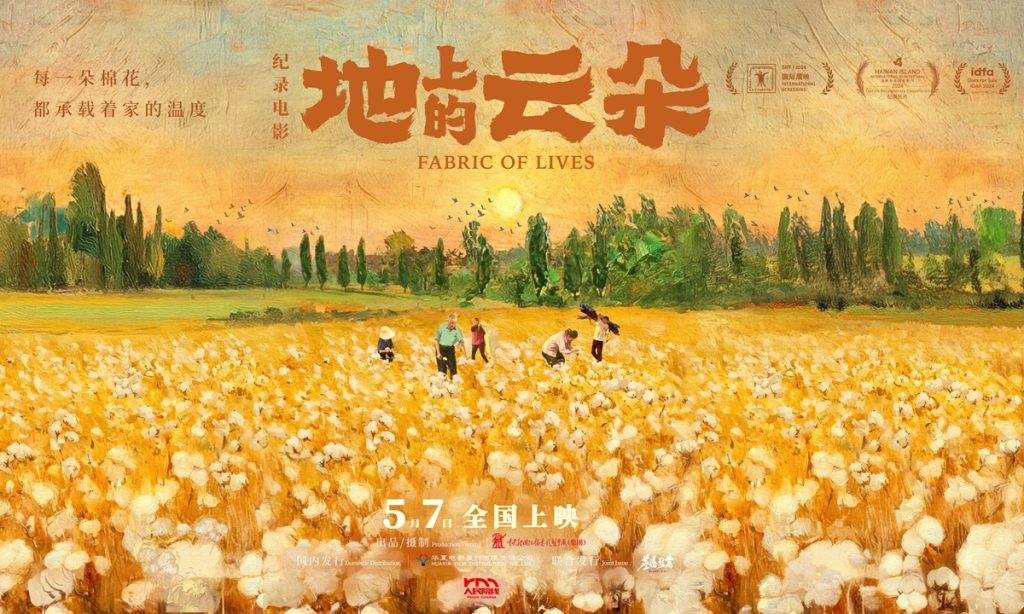Documentary film on stories of cotton farmers in Xinjiang region set for nationwide release on May 7

Fabric of Lives, a documentary film that follows the Arkin and Zhao Qiang families in Awat County – known as the home of Chinese long-staple cotton, in Northwest China’s Xinjiang Uygur Autonomous Region as they navigate the entire cotton production process, is set to premiere nationwide on May 7.
Filmed in a cinéma vérité style, the 80-minute documentary chronicles the families’ experiences during a challenging harvest season, marked by labor shortages, injuries and continuous rainfall. However, through perseverance and collaboration, the two families have overcome difficulties and ultimately achieved a rewarding harvest after a year of hard work.
The production team visited Awat twice in 2021 and 2023, embedding two cinematographers within the farmers' households to document daily life from an observational perspective. Fabric of Lives unfolds without a scripted narrative, relying entirely on real-life events to tell the story, Liu Guoyi, the film’s director told the Global Times.
“During the filming process, I tried to understand what cotton truly means to the local people. Perhaps I can sum it up by saying that their livelihoods, their lives, are carried on each and every cotton,” said Liu.
Ahead of its release, Fabric of Lives held a special cotton field premiere in Awat. Against the backdrop of the spring planting season, more than 600 villagers gathered at an open-air venue on the village outskirts to attend the screening, becoming the film's first audience.
In a temporary outdoor cinema, villagers watched familiar scenes of their labor and daily life unfold on the big screen. Members of the film’s production team, along with the Arkin and Zhao Qiang families, shared behind-the-scenes stories during the filming process. After the screening, villagers and guests celebrated together with singing and dancing, turning the event into a lively community gathering.
Xinjiang is China’s largest and one of the world’s key cotton-producing regions, accounting for over 90 percent of the country’s total output for several consecutive years. Cotton cultivation, processing and textile production are crucial industries that support income growth for people of all ethnic groups in the region. With the widespread adoption of mechanized farming, technologies such as Beidou navigation and autonomous driving have been applied throughout the cotton production process, significantly improving efficiency.
Although centered on cotton, the documentary offers a broader portrayal of Xinjiang, capturing its vibrant landscapes and the deep integration of the people from different ethnic groups. As Liu recalled, "One morning at breakfast, I had Xibe-style pancakes, Uygur naan, Kazakh milk tea, and porridge commonly seen in Beijing. It made me realize that Xinjiang is truly unlike any other place in China."
Before its release, the film has been selected for the 26th Shanghai International Film Festival’s International Film Showcase as the only Chinese film featured. It also appeared in the Docs for Sale section at the 37th International Documentary Film Festival Amsterdam and was shortlisted for Best Feature Documentary at the 6th Hainan Island International Film Festival.
Some viewers who have seen the film described it as “a poetic portrait of life in Xinjiang region amid modernization,” “an honest and moving depiction” and “simple, authentic, and natural, portraying people who live life with sincerity.”
"The hardworking and genuine cotton farmers show us just how rich life can be. Although life inevitably brings challenges, facing them bravely always leads to the best rewards," one viewer commented.
In recent years, Xinjiang’s breathtaking scenery and rich cultural narratives have drawn increasing interests from filmmakers and other creators. Wang Jiang, director of the Institute of China's Borderland Studies at Zhejiang Normal University, told the Global Times that although more domestic and international tourists are traveling to Xinjiang, their understanding of the region remains partial and fragmented due to short visits.
“Through documentary films and other visual works, people can gain a more comprehensive and intuitive understanding of the region,” Wang said.